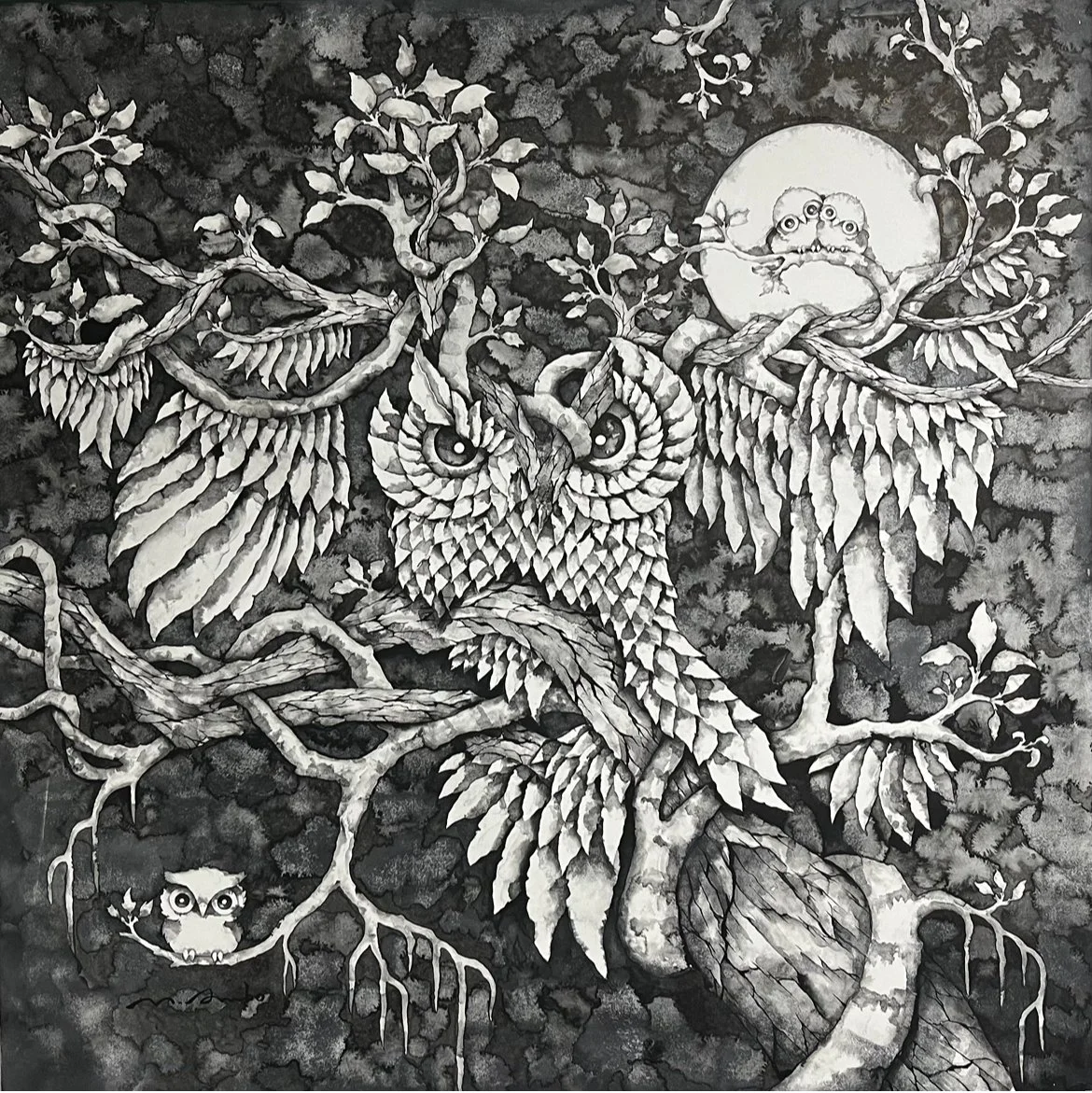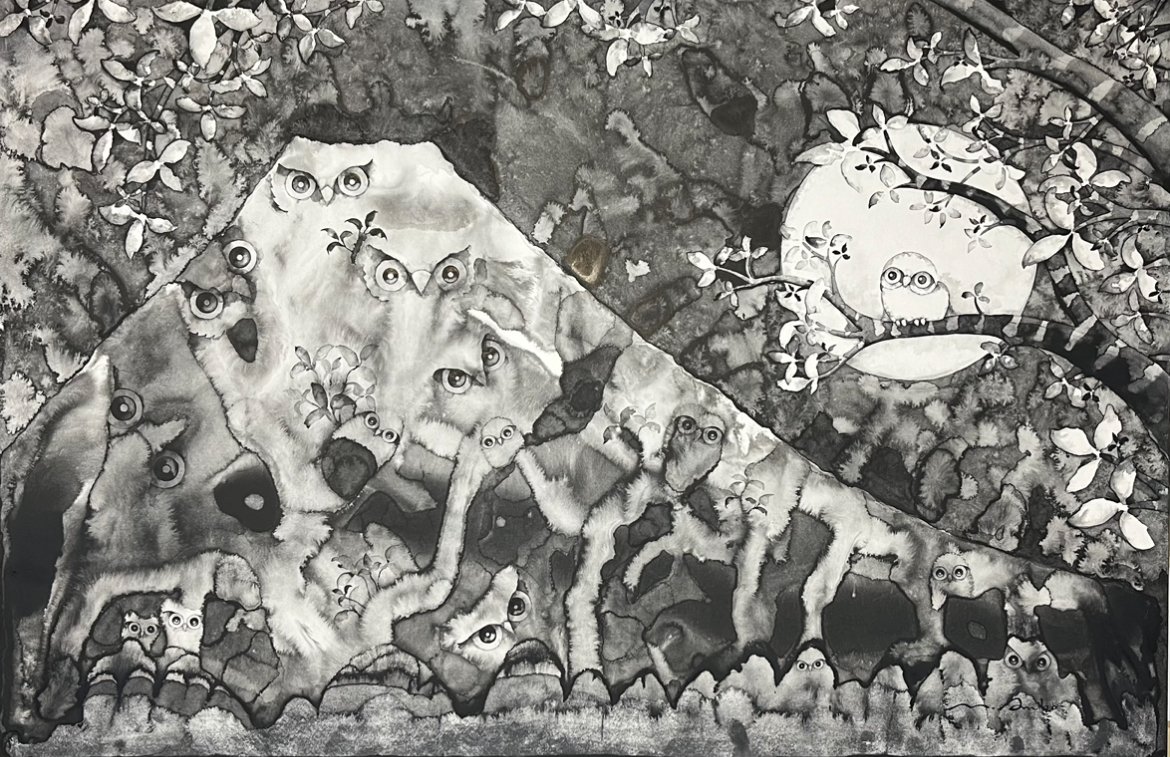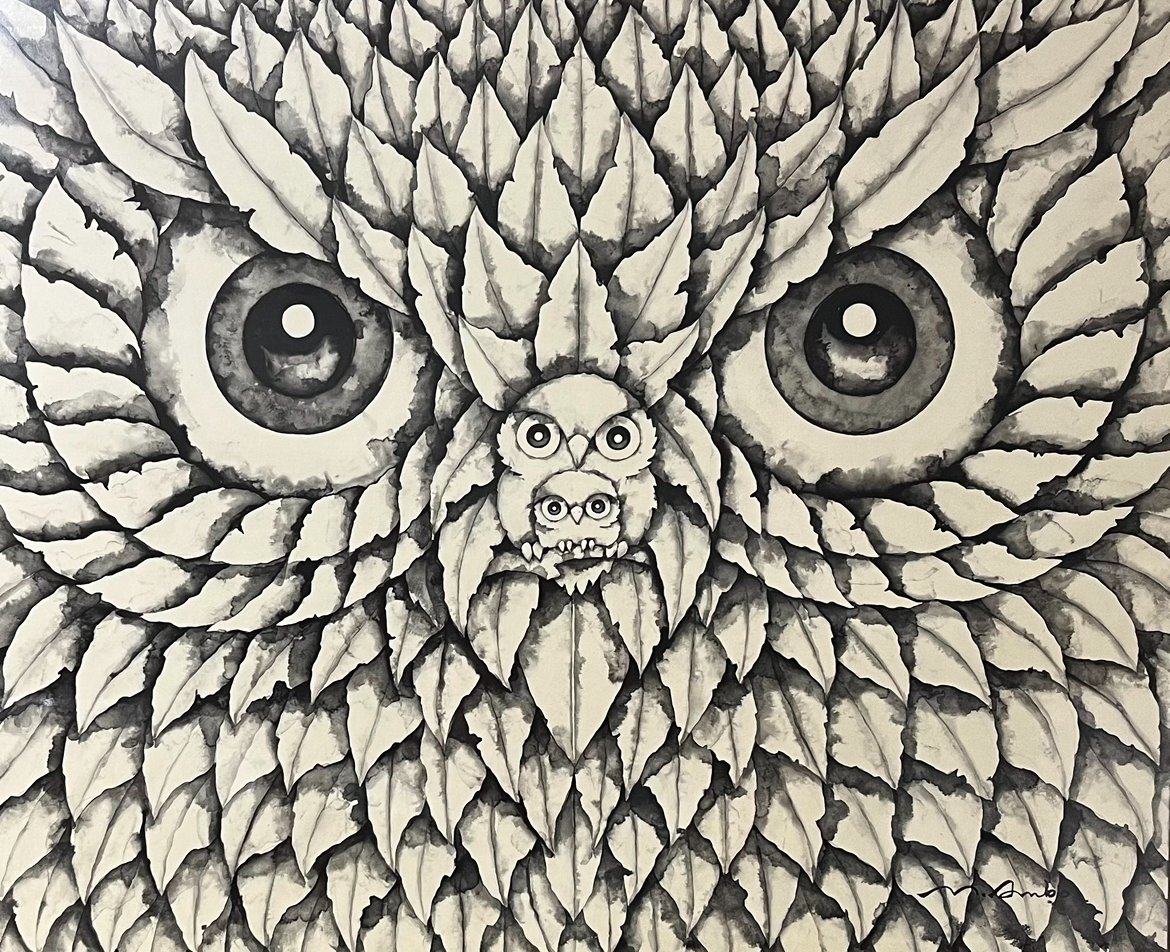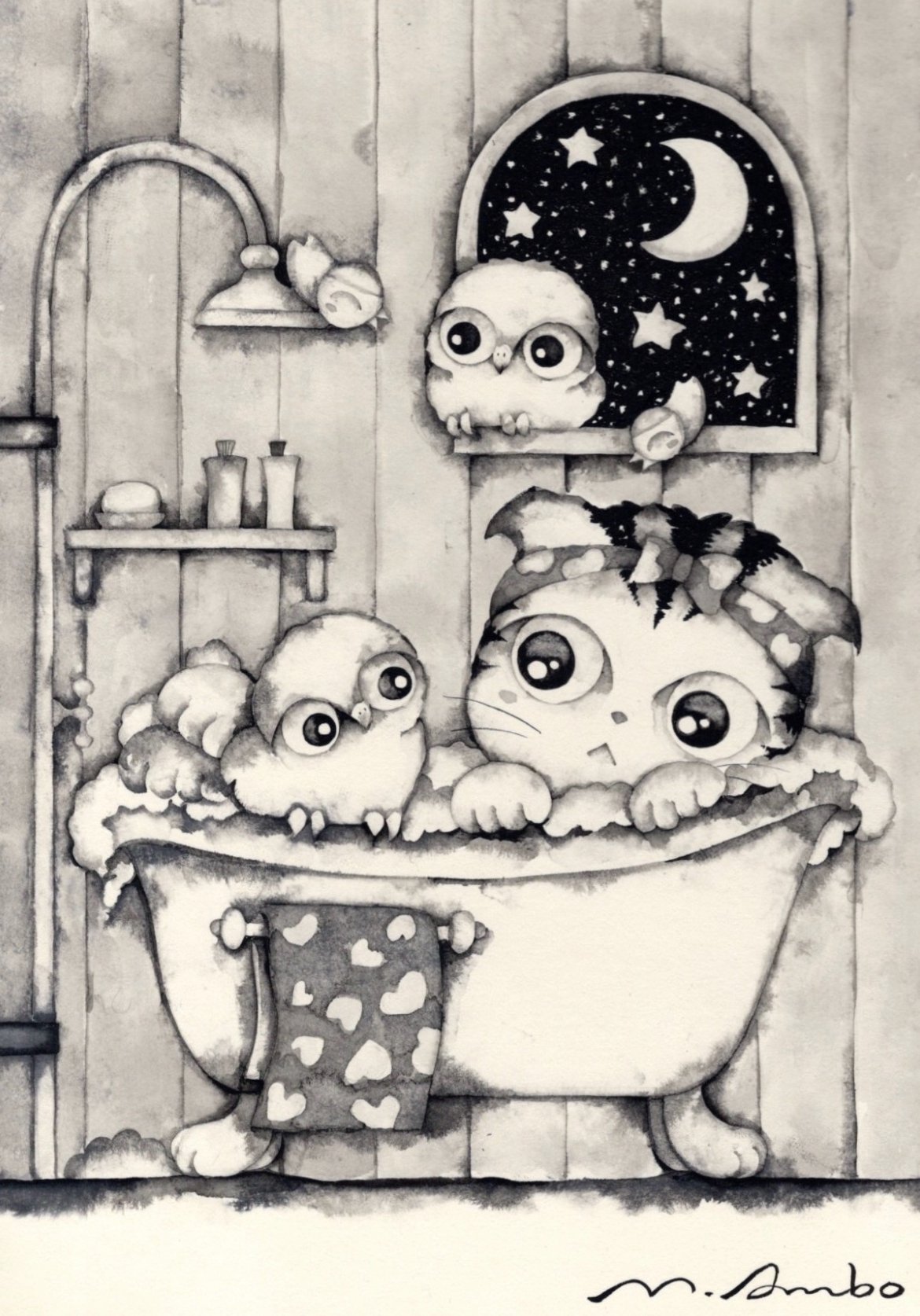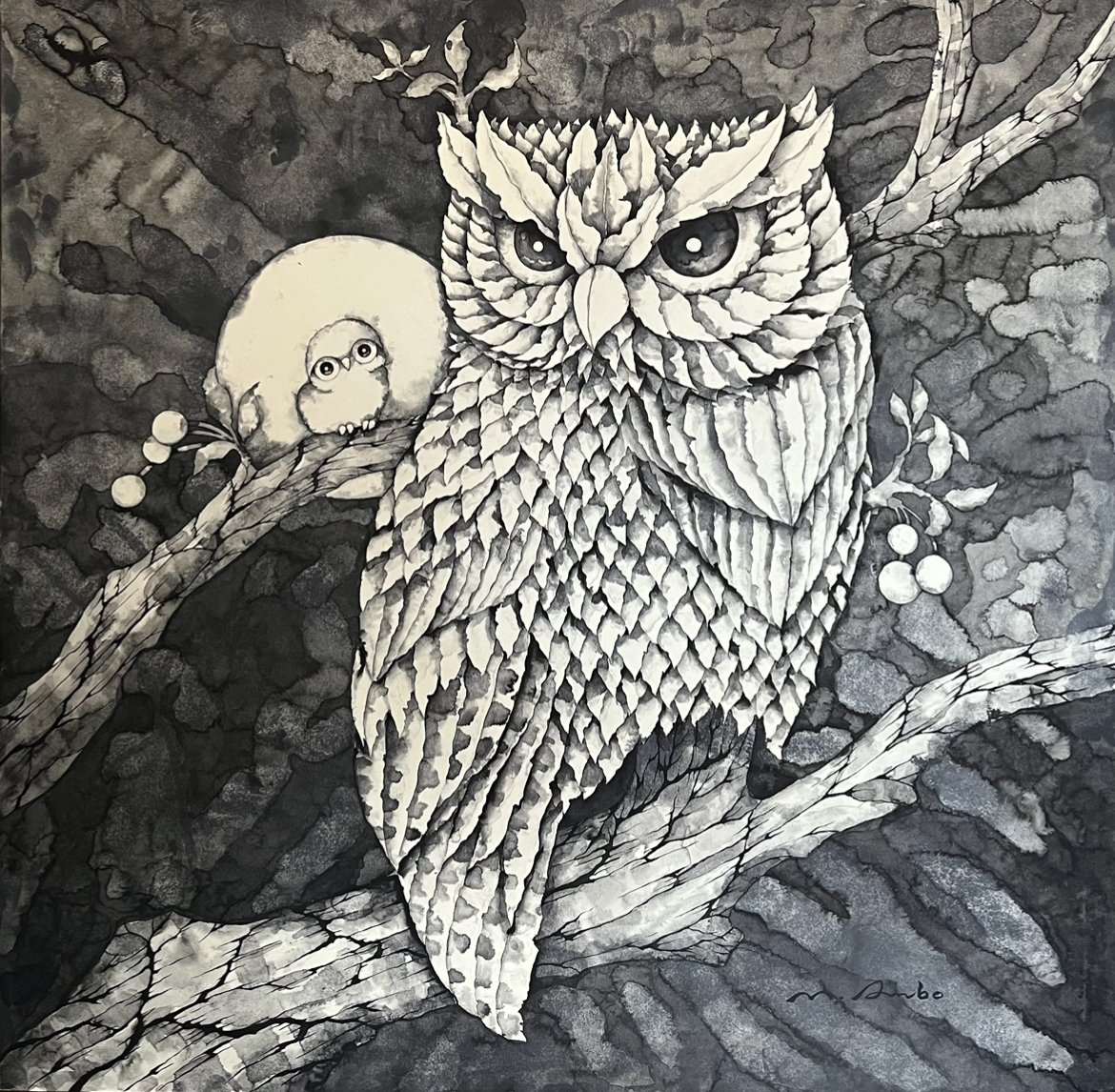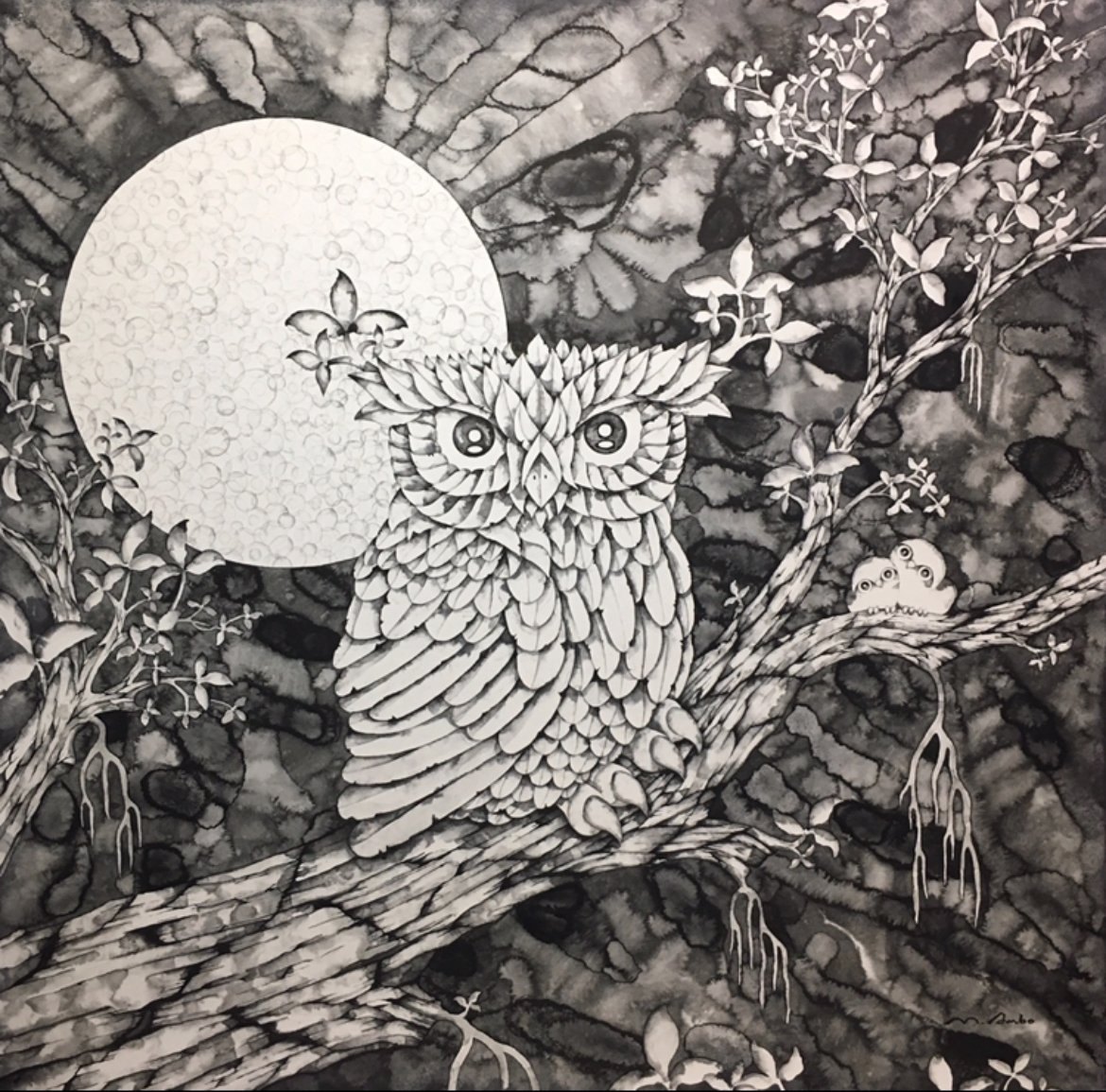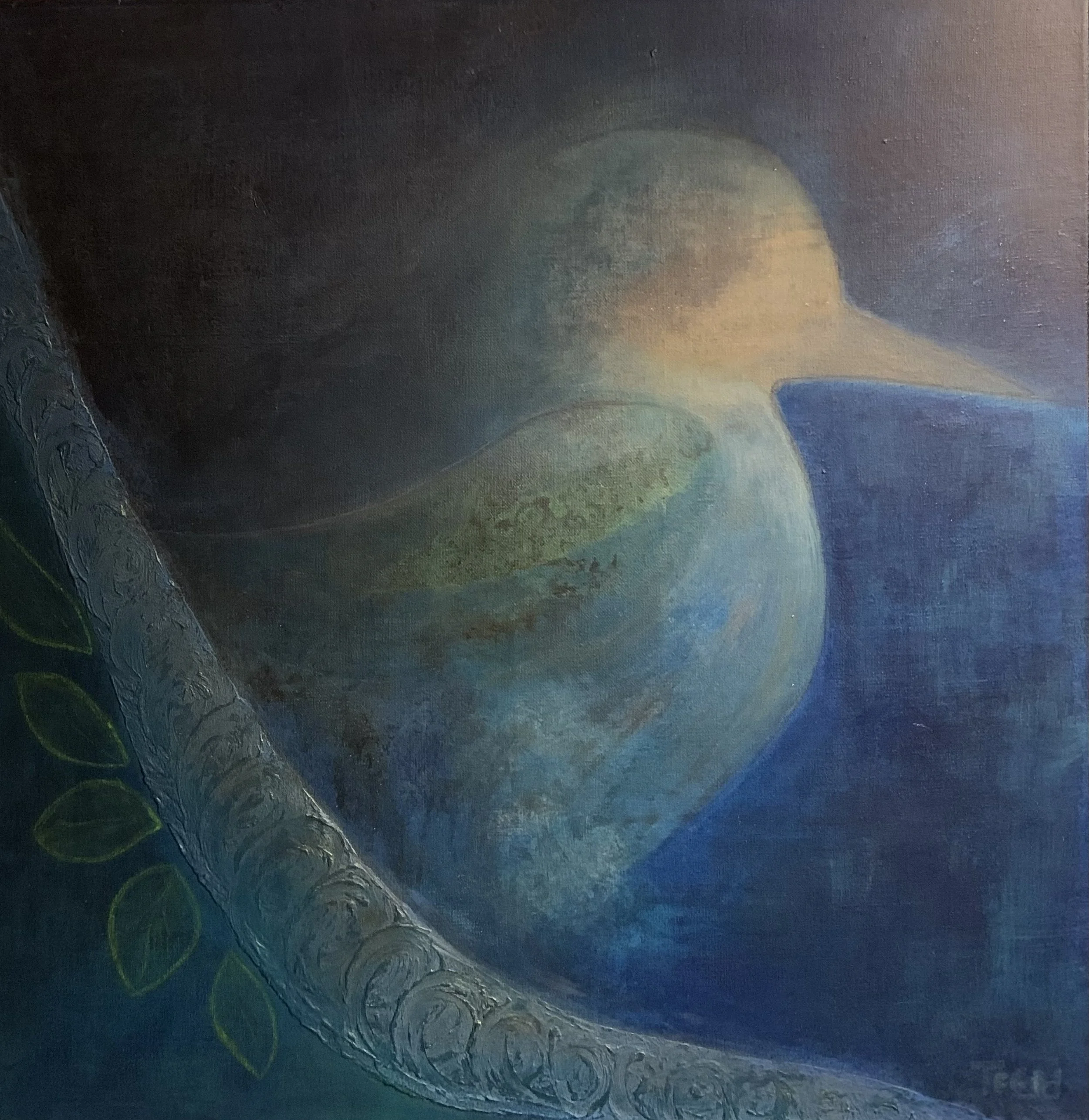Makoto Ambo
Makoto Ambo, a contemporary ink brush painter, has carved out a unique space in the art world with his distinctive technique known as Nijimi-ga or "Blur Painting." This innovative style, which employs the deliberate overpainting of ink bleeds, enables Ambo to create images that are deeply resonant with emotion and meaning, while also reflecting a masterful control of a notoriously unforgiving medium.
In the realm of Ambo's artistic creations, the theme of environmental protection is paramount. His depiction of owls is particularly poignant, as these creatures have long been symbols of wisdom and guardianship in many cultures, including the Ainu, an indigenous people of Japan. The owl’s role as a protector in Ainu mythology is fittingly paralleled by Ambo’s art, which acts as a sentinel for environmental awareness. The owls in his paintings are not mere subjects; they become stewards of the forest, observers, and participants in the natural world that Ambo renders with exquisite detail.
The complexity of his art is striking. His forests are dense with life, shadow, and mystery, evoking the intricacy of natural ecosystems. Each piece is a testament to the delicate balance of life, a balance that Ambo’s work urges us to protect. His use of monochromatic ink adds a sense of timelessness and gravity to the scenes, as if the stories contained within the paintings are as old as the myths they allude to, yet as urgent as the environmental issues we face today.
His approach to painting owls varies from the playful to the majestic, capturing the multifaceted nature of these birds. In some pieces, owls peer curiously out of the canvas, their large eyes serving as windows to their souls, inviting a dialogue about coexistence with nature. In others, the owls take on a more formidable presence, their feathers unfolding into the night sky, merging with the celestial bodies to signify the unity of all life forms.
In 2018, Ambo expanded his repertoire to include cats, and here again, his artistic mission intertwines with a social cause. He paints cats with a purpose to raise awareness and eliminate the senseless culling of these animals. The cats in his work, like the owls, are not mere animals but symbols of life's vulnerability and the need for compassion. The eyes of the cats, varied in expression from somber to surprised, serve as mirrors reflecting our own humanity back at us, urging a reevaluation of our relationship with living creatures.
Makoto Ambo’s foray into the feline world with his ink brush does more than just add a new subject to his portfolio; it introduces an entirely new narrative steeped in emotional depth and social commentary. His cats are not simply animals; they are emblematic of the broader issues of animal welfare and the human-animal bond. Each brushstroke and ink blot conveys the vulnerability and quiet dignity of these creatures, urging a sense of empathy and responsibility from the viewer.
The cats in Ambo’s artworks, much like the owls, carry a heavy symbolism. In many cultures, cats are associated with mystery and independence, as well as companionship and domesticity. Ambo leverages these associations to draw attention to the dichotomy of how cats are revered as pets on one hand, yet subjected to neglect and cruelty on the other. The expressive eyes of the cats in his paintings serve as focal points, drawing the viewer into a silent conversation about the worth of these lives and the callousness of their disregard.
Ambo's technique of Nijimi-ga, with its inherent fluidity, complements the elusive nature of cats. The ink bleeds across the canvas to form their silhouettes, as if suggesting the permeable lines between domesticity and wilderness, and the ease with which society’s affection can turn to indifference. In some pieces, the blurred forms also suggest movement, capturing the agility and grace characteristic of cats, while in others, there is a stillness that seems to await action or decision, perhaps a reflection of their fate in human hands.
The backgrounds of these pieces are particularly evocative, often populated with countless eyes and faces of cats. These multitudes speak to the overpopulation issues that contribute to their plight. Yet, even amidst these crowds, each cat is given individuality, hinting at the idea that every life has its own story deserving of attention.
Ambo's cats are also steeped in contrast. The starkness of the black ink against the white paper emphasizes the idea of cats as beings of light and shadow, seen and unseen, present in our lives yet often overlooked. This interplay of light and dark, clarity and obscurity, resonates with the societal ambivalence towards stray and feral cats.
In some compositions, the cats are depicted in a state of play or rest, evoking an innocence and purity. These moments of tranquility and joy stand in defiance of the harsh realities that many cats face. They remind us that beneath the societal challenges and the debates on animal rights, there are simple, universal moments of life to be cherished and protected.
By including cats in his artistic advocacy, Makoto Ambo broadens the emotional reach of his work. The cats serve as a lens through which we examine our actions and their impact on the natural and animal world. Through Ambo’s eyes, these creatures are not merely subjects of aesthetic appreciation; they are silent ambassadors for the voiceless, their plight captured in monochrome but their stories colored with the full spectrum of empathy and moral reflection.
Each cat in Ambo’s art, from the playful kitten to the stoic elder, is a character in a larger narrative—one that speaks to our capacity for both cruelty and care. They are a call to action, a reminder that art can be a powerful catalyst for change, and a testament to Ambo’s profound respect for life in all its fragile forms.
Ambo's work is more than just a visual treat; it's an invocation for change. His blending of environmentalism with art creates a silent, yet powerful, advocacy through his chosen medium. The Nijimi-ga technique, with its fluid and organic nature, becomes a metaphor for the very ecosystems he seeks to protect – just as the ink spreads and intermingles on the canvas, so too are all forms of life interconnected and interdependent.
What is truly exceptional about Ambo’s paintings is their ability to capture the viewer's imagination and hold it. The ink blots that form trees, creatures, and mythical beings invite one to look closer, to find order in the chaos, meaning in the abstract. Each viewing reveals new shapes, new stories, and new interpretations, much like nature itself, which offers endless inspiration and continuous discovery.
The mythological elements in Ambo’s art are not just references to old tales but serve as a bridge between the past and present. They remind us that nature was once revered and considered sacred, a notion that modernity has often neglected. By bringing these myths to life through his art, Ambo rekindles a sense of reverence for the natural world and invites viewers to reclaim this ancient wisdom.
Makoto Ambo's art is a dialogue between the artist, the viewer, and the environment. It's a dialogue that speaks of beauty, responsibility, and the irreplaceable value of life in all its forms. Through the silent language of ink and the powerful symbolism of owls and cats, Ambo's work makes an impassioned plea for the protection of our natural world, and for the remembrance of our place within it – not as conquerors, but as custodians. His paintings are an embodiment of the belief that art can not only represent the world we live in but can also imagine the world we strive for.
Makoto Ambo’s art carries with it a profound significance that extends far beyond the boundaries of the canvas. In a world where environmental concerns and animal welfare issues are increasingly pressing, his works stand as both a refuge and a clarion call. His importance in contemporary art, and indeed within the broader cultural landscape, lies in his ability to marry aesthetic innovation with a strong ethical message.
Ambo’s Nijimi-ga, or Blur Painting, transcends mere technique. It becomes a language through which the interconnectedness of all life is expressed. The bleeding of ink on paper mirrors the way ecosystems and species, humanity included, bleed into one another, influencing and shaping the destiny of our planet. This visual metaphor is a powerful reminder of the ripple effects our actions can have in the natural world.
Ambo's focus on owls and cats, and the larger themes they represent, casts him as an artist deeply attuned to the zeitgeist. As environmental degradation and biodiversity loss become increasingly undeniable, his work invites reflection on the human role in these phenomena. His paintings are a meditation on the beauty of the natural world and the tragedy of its exploitation, resonating with a global audience that is becoming more aware and concerned about these issues.
In the art scene, Ambo's work occupies a unique niche where fine art meets activism. While many artists address social issues indirectly, Ambo's work is direct without being didactic, emotional without being sentimental. His art does not simply depict reality; it challenges and reimagines it, urging us to envision a world where humans live in harmony with nature rather than at odds with it.
His art is a celebration of the diversity of life and a somber reflection on its fragility. The owls and cats are not just subjects but symbols of broader concerns. They draw in art enthusiasts, environmentalists, animal lovers, and cultural commentators alike, serving as a bridge between disparate groups and fostering a collective dialogue on important issues.
His work reinvigorates traditional techniques for a modern audience. Ink brush painting is an ancient art form, and Ambo's contemporary take on it brings it to new audiences who might not otherwise engage with it. This fusion of old and new ensures that traditional art forms continue to evolve and remain relevant.
Makoto Ambo’s place within the art scene is as a bridge-builder—between tradition and innovation, art and advocacy, humanity and nature. His work is a reminder that art is not just for art's sake; it can be a potent vehicle for change, a mirror held up to society, and a map pointing toward better paths. In this way, Ambo’s art becomes important not just for what it is, but for what it can inspire us to become: more conscientious stewards of the world we inhabit.
By Marta Puig
Editor Contemporary Art Curator Magazine

